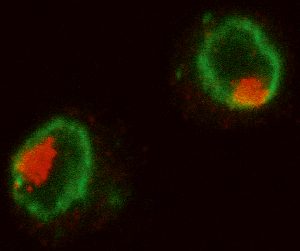A balancing act between the sexes
Genetic differences between males and females might be evened out at the rim of the nucleus

Recent research at the European Molecular Biology Laboratory (EMBL) reveals new insights into how cells achieve equality between the sexes. A new link discovered between the membrane surrounding the nucleus and the male X-chromosome in fruit flies may play a crucial role in determining how active certain genes are. The study, which appears in the current issue of the journal Molecular Cell, may help researchers understand how male and female cells manage to produce the same quantities of certain proteins.
“The problem arises because the females of many species from insects to humans have two X-chromosomes whereas males have only one”, says Asifa Akhtar whose group carried out the project at EMBL. “Since genes contain the recipes for proteins this would normally lead female cells to produce twice as many of the proteins encoded by the X-chromosome as males. Balance is achieved through the activity of an assembly of proteins, called the dosage compensation complex (DCC).”
In flies the DCC hyperactivates the male X-chromosome to double the amount of proteins it produces. Investigating how this hyperactivation is brought about Akhtar’s group discovered that the DCC interacts with molecules that sit in the nuclear membrane where they form gateways to the nucleus. This interaction seems to play an important role in dosage compensation, because when the pore proteins are removed from a cell the hyperactivity of the Xchromosome is lost.
“We have found a complex with striking similarities to the fly DCC in human cells”, says Sascha Mendjan from Akhtar’s group. “This leaves room for speculations about its role in dosage compensation in mammals. Unlike flies, mammals inactivate one of the female X-chromosomes to match the protein contents between the sexes. But the fact that the machinery is evolutionary conserved suggests a common molecular basis from which the different mechanisms evolved.”
The next step will now be to find out how exactly the membrane proteins influence the gene activity in different species. One possibility is that organising groups of genes in domains close to the membrane allows a cell to control their activity in a co-ordinated fashion.
“The nuclear membrane and the gateways to the nucleus are central meeting points in the cell where many different pathways overlap”, says Jop Kind, a researcher in Akhtar’s lab. “This makes them a strategic location not only to co-regulate groups of genes but also to coordinate them with other crucial cellular processes.”




